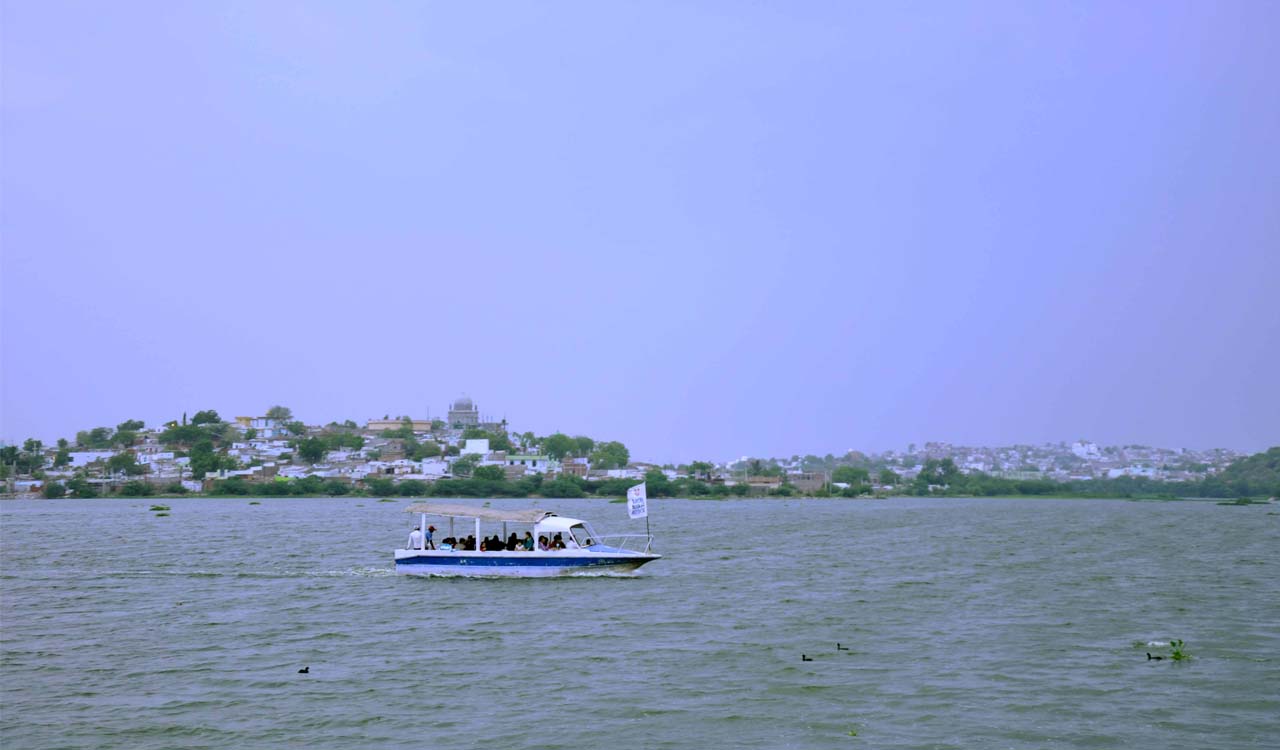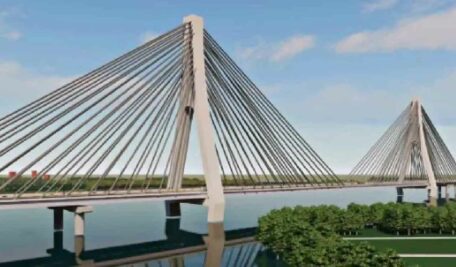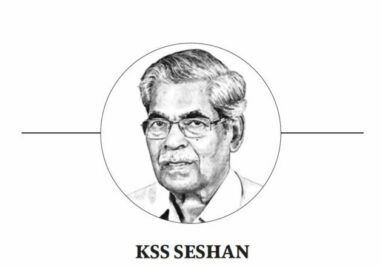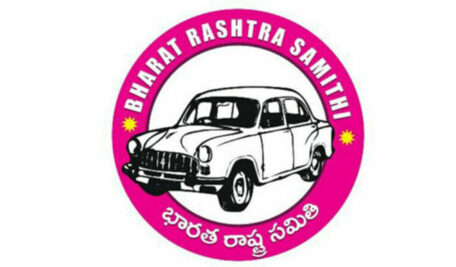Rewind: Hyderabad’s Mir Alam Tank and its Mysore connection
Built in 1806 by Diwan Mir Alam with funds from the Mysore war, Hyderabad’s Mir Alam Tank stands as a blend of engineering brilliance, political history, and architectural marvel

By KSS Seshan
The silent waters of MirAlam Tank mirror the stories of the past, even as Hyderabad’s skylines are changing rapidly. The tank, built over two hundred years ago by Diwan Mir Alam with funds from the Mysore war, is set to get a facelift. The government’s decision to construct a 2.5 km-long cable bridge across the tank in the Bahadurpur area of the old city deserves appreciation. Once completed, the Mir Alam Tank bridge will be the second suspension bridge in the city after the iconic Durgam Cheruvu bridge near Jubilee Hills.
Also Read
According to reports, the government also plans to develop the tank and its adjoining area into a tourist attraction, with three island zones modelled on the lines of Singapore’s gardens. The proposed development includes convention centres, adventure parks, artificial waterfalls, resorts, and hotels. The project is expected to be taken up in a public-private partnership (PPP) mode. A bird sanctuary, similar to the Jurong Bird Park in Singapore, and an amphitheatre have also been planned near the tank, along with a musical fountain, touted as a star attraction of the project.
Located south of the River Musi, the Mir Alam Tank was the main source of drinking water for Hyderabad before the construction of Osman Sagar and Himayat Sagar reservoirs during the reign of Mir Osman Ali Khan, following the recommendations of Sir Mokshagundam Visvesvaraya after the catastrophic 1908 Hyderabad floods.
Architectural Marvel
Constructed between 1804 and 1806, the tank features several unique technical and architectural elements, including 21 semicircular masonry arches that extend approximately 1.5 km in length, forming a structural foundation for the large reservoir. These arches make it an engineering marvel of its time, combining functional water storage with an aesthetic and structural innovation still admired today.
It is said that the tank was designed by a French engineer, Michel Joachim Marie Raymond (not to be confused with his namesake, who built the Gunfoundry). Though there was a considerable decline of French influence in Hyderabad after the signing of the Subsidiary Alliance introduced by Wellesley in 1800, French personnel continued to influence the military, social, and cultural life of Hyderabad. No wonder Mir Alam engaged a French planner to build his tank. The tank covers an area of 260 acres and has a capacity of 21 million cubic metres of water, fed by numerous streams and springs from the nearby hills.
Nizam’s favourite drink
The water of Mir Alam Tank was said to be so sweet that Mir Mahboob Ali Khan, the VIth Nizam (1869-1911), insisted on drinking water only from this tank. When he travelled to Delhi for the 1877 Durbar, large steel containers filled with the tank water accompanied him aboard his luxury train ‘Palace on Wheels’. The specially made containers were procured from London. It is believed that the Nizam preferred water drawn from a particular spot in the middle of the tank, where an underground spring gave it a distinct sweetness. His attenders would row out daily to that spot to fetch his drinking water
Ally of the British
Mir Alam Bahadur, the builder of the tank, was a prominent nobleman and the Prime Minister (Diwan) of Hyderabad State from 1804 to 1808 during the reign of Sikander Jah, the third Nizam (1803-1829). Construction of the tank began in July 1804, and it was completed in two years, being commissioned by Mir Alam himself in June 1806. He drafted engineers and craftsmen at great expense for its construction.
He was instrumental in aligning Hyderabad state closely with British interests, which had lasting implications for the region’s political dynamics. His leanings towards the British also weakened the autonomous military power of the Hyderabad state and enabled the rise of British influence in the Nizam’s territory. Mir Alam had very cordial relations with the British East India Company administration and utilised it to fix his political rivals and also to further his personal gains. His most notable rivalry was with Arastu Jah, his predecessor as Diwan of Hyderabad state.
There was an ongoing bitter rivalry between them. Arastu Jah wanted to discredit then Resident James A Kirkpatrick, with Mir Alam being involved in that highly charged political contention. Mir Alam gained a lot of political mileage by supporting Kirkpatrick. However, the episode resulted in the rise of pro-British and anti-British factions in the Nizam’s court. Mir Alam sided with the pro-British and extended even military help during the final Mysore war against Tipu Sultan. The British, in turn, played kingmakers, supporting Mir Alam against Arastu Jah to stabilise Hyderabad in their favour.
Role in Mysore War
It was Mir Alam who commanded the Hyderabad contingent during the siege of Srirangapatnam in the fourth Mysore war against Tipu Sultan in 1799. His forces included 10,000 cavalrymen and four battalions of infantry. Six more East India Company battalions, led by James Dalrymple, joined them. These combined Hyderabad forces became part of the British Grand Army led by George Harris for the final assault on Srirangapatnam in April-May 1799.

The Hyderabad contingent under Mir Alam played a key role in the combined allied British army of more than 50,000 soldiers that included British, Maratha, and Portuguese troops. Upon returning to Hyderabad on the conclusion of the war and the signing of the Treaty of Mysore, Mir Alam was accorded a hero’s welcome.
War Booty
The large funds Mir Alam spent on constructing the tank were received from Mysore and have an interesting historical background. Under the Treaty of Mysore, a large part of the kingdom was divided among the victors. To the truncated Mysore, Krishna Raja III, a scion of the Wadiyar family, was restored to the throne. The entire territories south of the Krishna river, the present Rayalaseema area in Andhra Pradesh, went as the share of the Nizam of Hyderabad, which he ceded to the East India Company in 1800 under the Subsidiary Alliance signed with Lord Wellesley. Hence the name, ‘Ceded Districts’ to the area under British rule. Tipu Sultan’s vast treasures, his throne, swords, jewels, and innumerable artefacts, were looted and divided among the victors.
At the Treaty, Hyderabad was represented by the young and ambitious Mir Alam, who at that time was only Peshkar. But he had the distinction of having led Hyderabad’s cavalry in the final siege of Srirangapatnam. Arastu Jah, the Diwan at that time, was busy with state affairs under the ageing Nizam Ali, then Nizam of Hyderabad.
When the innumerable artefacts of Tipu were being divided, Mir Alam’s eyes fell on the attractive and unusually large chandeliers in the court halls of Tipu’s Srirangapatnam Palace. These chandeliers were designed by French artisans. They were carefully transported to Hyderabad, and now they adorn the Chowmahalla Palace near Charminar in Hyderabad. These are reputed to be the largest chandeliers in the country. Mir Alam also received substantial monetary gifts for his role in the war as well as at the peace conference. He used this undisclosed personal fortune to construct the tank that bears his name after he became the Diwan under Nizam Sikander Jah (1803-1829).
The Mandi lives on
Mir Alam is also credited with founding the iconic Mir Alam Mandi, near Charminar, an enduring legacy of the former Diwan. Spread over five acres, it is the oldest and one of the busiest markets in Hyderabad, housing around 300 vendors and 40 regular shops, selling fresh vegetables, fruits, grains, and spices. A special feature of the market is its historic grand Kaman (archway) that was recently restored to preserve its original design and 200-year-old charm
Support to British
During the reign of the second Asaf Jah, Nizam Ali (1762-1803), the British entered into several alliances detrimental to Hyderabad state. In 1766, the Nizam ceded the Northern Circars, and in 1800, he was forced to sign the Subsidiary Alliance, surrendering the Ceded Districts and disbanding his forces.
The British thus became a paramount power, which was resented by a large section of the Hyderabad nobility. When Sikander Jah ascended the throne (1803-1829), a strong anti-British faction emerged at court. However, Mir Alam, recognising that the British were invincible, joined the Resident and gradually rose in ranks. He masterminded the expulsion of Raja Mahipatram, who revolted against the British. Sikander Jah was left with little option but to make Mir Alam Diwan.
Family Legacy
Mir Alam’s family hailed from Iran. His father, Syed Reza, migrated to and settled in Hyderabad. He had close links with the Salar Jung family. In fact, Mir Alam was the progenitor of the Salar Jung family of Diwan. His son-in-law Munir-ur-Mulk was the paternal grandfather of Salar Jung. Munir’s eldest son, Mohammad Ali Khan, father of Salar Jung, passed away when the latter was just two years old. Munir-ul-Mulk served as the Diwan during the 1830s. His second son, Siraj-ul-Mulk, was the Diwan during 1851-53. Salar Jung succeeded his uncle in 1853, serving as Diwan until 1883, and came to be rightly known as the maker of the modern Hyderabad state.
Starting as a Vakil, Mir Alam rose through diplomacy, intelligence, and hard work. Mir Alam died in 1808 while serving as Prime Minister and is buried in Daria Mir Momin, not far from Mir Alammandi. The tank he built remains a permanent tribute to this philanthropist Prime Minister who, through his alignment with the British, shaped Hyderabad’s policies during the early phase of British indirect rule. Mir Alam, besides his political and military contributions, was a Persian scholar and a great philanthropist. He also built Caravansaries (rest houses) on important routes from Hyderabad to Pune and Masulipatam (Machilipatnam) for the benefit of travellers.
The Telangana government hopes the Mir Alam Tank, adjoining the Nehru Zoological Park, will gain unprecedented popularity once the beautification works are completed. One only hopes the State government is genuinely serious about the facelift so that this heritage landmark regains the pride of place it once enjoyed.

(The author is a retired Professor of History, University of Hyderabad)
Related News
-
Three Americans killed; U.S. vows response to ISIS attack in Syria
3 hours ago -
Women’s rescue team shines as Singareni wins big at All India Mines Rescue Competition
3 hours ago -
Komuravelly Kalyana Mahotsavam to mark start of annual jathara
4 hours ago -
Over 8 lakh voters to cast ballots in Arunachal polls on Dec 15
4 hours ago -
AIIMS-led trial proves Supernova Stent safe and effective for stroke patients
4 hours ago -
Man killed, wife injured in Sangareddy road accident ahead of panchayat polls
4 hours ago -
Nitish Kumar Reddy claims hat-trick for Andhra in Syed Mushtaq Ali Trophy
4 hours ago -
Triveni Continental Kings eye hat-trick in Global Chess League
4 hours ago




